by Paul White
Updated July 31st, 2020
We have been seeing a lot of these honey trucks over the past weeks. These bees were gathering nectar from surrounding pine trees and were busy swirling around the hives. The owner advised me not to go any closer as he said they wouldn't like my camera because it's black in colour?
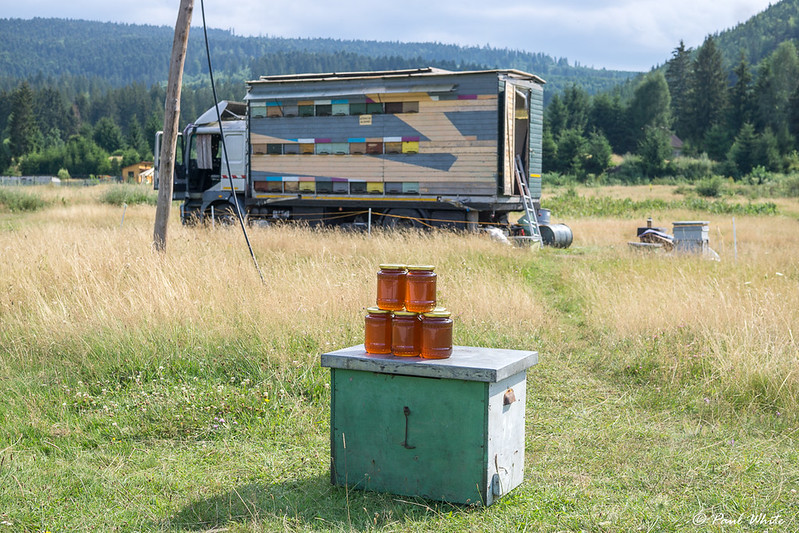
I'd never heard this before so when I got home I researched this new piece of information online, and sure enough bees (and wasps) perceive dark colours, especially black and red as threatening and can become hostile and defensive, even with small dark objects.
Updated July 23rd, 2020
We saw this rather impressive truck last evening full of beehives. There's lots of bears in this forest covered mountain pass, which explains the requirement for a 3 tier electric perimeter fence. Beekeepers often park up for a couple of weeks at a time depending on what type of honey they want (i.e acacia) and for farmers that want fields pollinating (i.e oil seed rape and sunflowers). Many of them tow a caravan to sleep in but this truck has a sleeping area at the back of the cab. I have a couple of friends that do this regularly through to autumn and for added protection from bears, keep large dogs with them too.

Updated May 19th, 2012
There is one popular rural industry that up to now I have paid little attention to and that is beekeeping and honey production. Why? Because I knew there would be a high risk of getting stung! But I can no longer afford to ignore the vital work of the beekeepers, whose bees not only pollinate local crops but also produce fine honey from a natural environment.

There are several families in the village that concentrate on honey production as their main source of income, whilst others see it as more of a pastime, supplementing their diet with honey produced on wild inter-forest meadows. This page which is dedicated to the beekeepers of the eastern Carpathians and their honey production and I will endeavour to update you with the latest stories and facts surrounding this industry over the next twelve months.


Lukacs Hunor is my neighbour and he comes from a family of beekeepers, whose main income is generated from honey sold on local markets. Hunor kindly showed me the components of beehives that they manufacture on site. That said he only managed to get halfway through this demonstration due to heavy rain, so I will complete it another day.

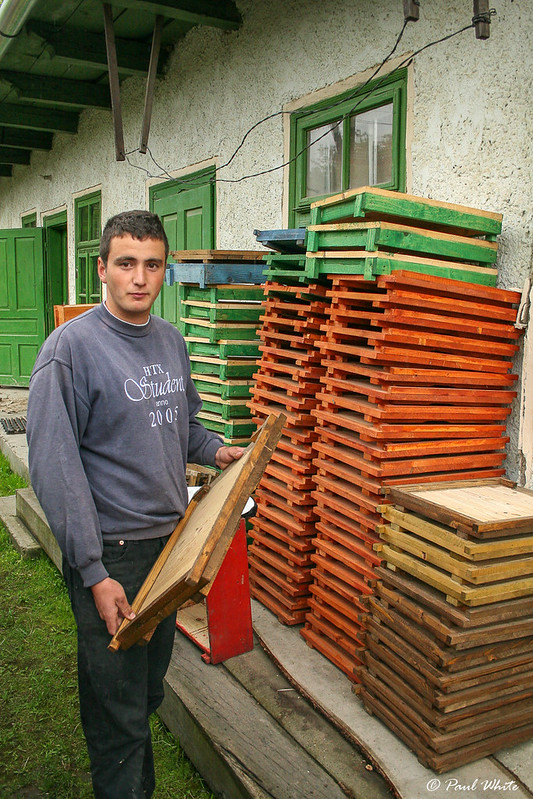
The base of the hive is simply called the floor. This is raised off the ground using battens, which helps keep the beehive dry.
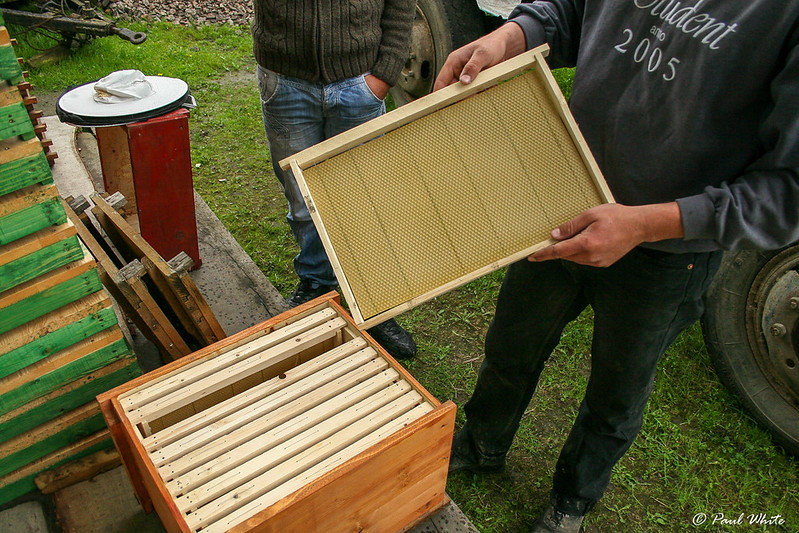
The brood chamber is the lowest compartment of the beehive and where the queen lays her eggs and lives with her workers throughout the year. The brood chamber is divided using the larger brood frames which are evenly spaced across the brood chamber as can be seen above.
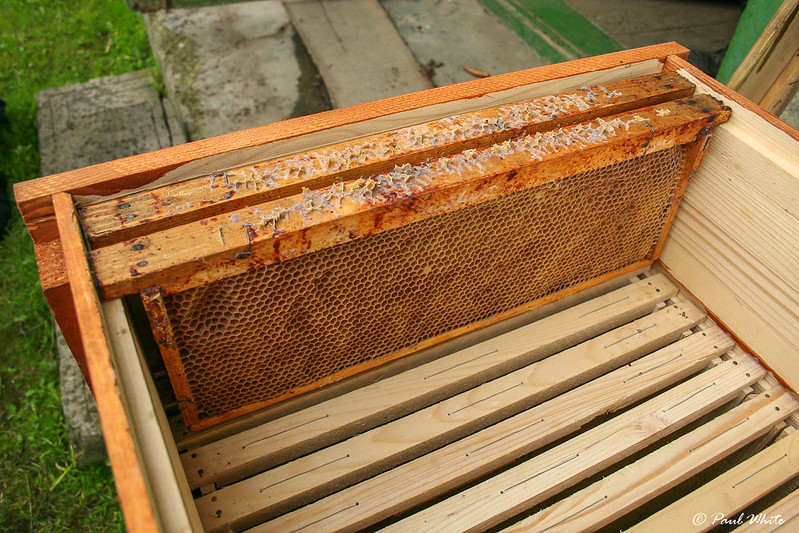
As the colony increases in size additional boxes can be added to the hive called 'honey supers' which contain smaller frames. These are used to collect honey, but are separated from the brood chamber using a 'queen excluder', a frame made up of fine metal rods wide enough to allow worker bees access, but prevents the queen from laying eggs in the upper chambers. The 'queen excluder' is missing from the photograph above.

Once the honey has been extracted from the honeycombs it is stored in large vats in Hunor's family kitchen. Local villagers can then buy honey directly from the producer, decanted into jars. It's a great feeling to know that this honey was produced no further than 20 metres from the vats. Few 'food miles' there!
Updated June 27th, 2008
What was my first experience of beekeeping in Transylvania? Well I would have to say my first exposure to beekeeping started on my off road trips into the forest covered mountains. I was always surprised by how far they could penetrate into remote areas by dragging their 'honey trailers' along logging routes with tractors. They then set them up on forest meadows where bees would benefit from high levels of pollen and nectar provided by wild flowers and trees from the surrounding forest.
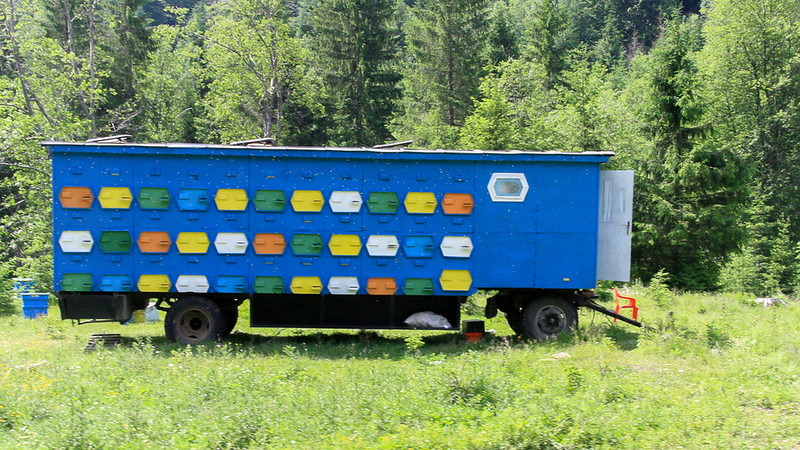
Beekeepers usually stay with their hives due to the presence of large numbers of bears. You can also see behind the trailer individual hives spread out which are surrounded by electric fencing. Large dogs are also brought along to deter the most determined bears.
Updated July 31st, 2020
We have been seeing a lot of these honey trucks over the past weeks. These bees were gathering nectar from surrounding pine trees and were busy swirling around the hives. The owner advised me not to go any closer as he said they wouldn't like my camera because it's black in colour?

I'd never heard this before so when I got home I researched this new piece of information online, and sure enough bees (and wasps) perceive dark colours, especially black and red as threatening and can become hostile and defensive, even with small dark objects.
Updated July 23rd, 2020
We saw this rather impressive truck last evening full of beehives. There's lots of bears in this forest covered mountain pass, which explains the requirement for a 3 tier electric perimeter fence. Beekeepers often park up for a couple of weeks at a time depending on what type of honey they want (i.e acacia) and for farmers that want fields pollinating (i.e oil seed rape and sunflowers). Many of them tow a caravan to sleep in but this truck has a sleeping area at the back of the cab. I have a couple of friends that do this regularly through to autumn and for added protection from bears, keep large dogs with them too.

Updated May 19th, 2012
There is one popular rural industry that up to now I have paid little attention to and that is beekeeping and honey production. Why? Because I knew there would be a high risk of getting stung! But I can no longer afford to ignore the vital work of the beekeepers, whose bees not only pollinate local crops but also produce fine honey from a natural environment.

There are several families in the village that concentrate on honey production as their main source of income, whilst others see it as more of a pastime, supplementing their diet with honey produced on wild inter-forest meadows. This page which is dedicated to the beekeepers of the eastern Carpathians and their honey production and I will endeavour to update you with the latest stories and facts surrounding this industry over the next twelve months.


Lukacs Hunor is my neighbour and he comes from a family of beekeepers, whose main income is generated from honey sold on local markets. Hunor kindly showed me the components of beehives that they manufacture on site. That said he only managed to get halfway through this demonstration due to heavy rain, so I will complete it another day.


The base of the hive is simply called the floor. This is raised off the ground using battens, which helps keep the beehive dry.

The brood chamber is the lowest compartment of the beehive and where the queen lays her eggs and lives with her workers throughout the year. The brood chamber is divided using the larger brood frames which are evenly spaced across the brood chamber as can be seen above.

As the colony increases in size additional boxes can be added to the hive called 'honey supers' which contain smaller frames. These are used to collect honey, but are separated from the brood chamber using a 'queen excluder', a frame made up of fine metal rods wide enough to allow worker bees access, but prevents the queen from laying eggs in the upper chambers. The 'queen excluder' is missing from the photograph above.

Once the honey has been extracted from the honeycombs it is stored in large vats in Hunor's family kitchen. Local villagers can then buy honey directly from the producer, decanted into jars. It's a great feeling to know that this honey was produced no further than 20 metres from the vats. Few 'food miles' there!
Updated June 27th, 2008
What was my first experience of beekeeping in Transylvania? Well I would have to say my first exposure to beekeeping started on my off road trips into the forest covered mountains. I was always surprised by how far they could penetrate into remote areas by dragging their 'honey trailers' along logging routes with tractors. They then set them up on forest meadows where bees would benefit from high levels of pollen and nectar provided by wild flowers and trees from the surrounding forest.

Beekeepers usually stay with their hives due to the presence of large numbers of bears. You can also see behind the trailer individual hives spread out which are surrounded by electric fencing. Large dogs are also brought along to deter the most determined bears.